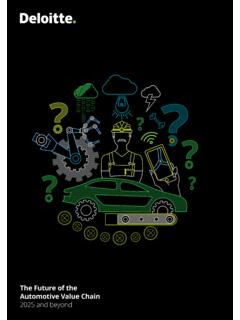Transcription of Banking business models of the future - Deloitte
1 Banking business models of the futureDr. Daniel KoblerPartner Banking Innovation Leader DeloitteDr. Stefan BuchererSenior ManagerConsultingDeloitteJohannes SchlotmannSenior ConsultantConsultingDeloitteBanking is undergoing a significant change and all current business models are under scrutiny. Digitization is the most significant of several universal trends and disruptive new entrants may fundamentally change the competitive environment. We have identified three potential scenarios for the Banking of the future and believe that now more than ever, banks need to choose a strategic business model and adapt it in accordance with the prevailing scenario.
2 In light of these choices, banks must take action today to be prepared for disruptions challenging the traditional role of banksNew technologies are radically changing the traditional Banking business model. From the way banks interact with customers to the way banks manage their middle and back office operations, technological innovations are challenging traditional processes across the entire value technology could radically simplify the payments and transactions worldDigital investment solutions such as robo-advisors enable automated investment advisory servicesBiometric technologies allow for seamless and secure digital authenticationGamification offers a more enjoyable and meaningful customer experienceProcess automation offers large-scale cost reduction in combination with increased flexibility and accuracy of back
3 Office tasksEXAMPLES OF GAME-CHANGING DISRUPTIONST oday, there are several examples of game-changing disruptions that suggest how Banking may develop in the future : PaymentsDecentralized currencies, , leveraging Blockchain technology and mobile money solutions provide compelling alternatives to traditional value transferring systems by streamlining intermediation processes. Driven by competitive pressure from these innovations, the future of value transfer will be more global, more transparent, faster and cheaper. Contrarily, the seamless integration of payment transactions into the purchase process (for example Amazon 1-click or Uber) reduces touchpoints between payment providers and customers, making it harder for payment providers to differentiate themselves from the competition.
4 Deposits and lendingAlternative lending platforms leveraging peer-to-peer models are transforming credit evaluation and sourcing of capital, as well as, narrowing the spread between deposits and lending. Platforms such as Lending Club, Zopa and Lenddo use alternative adjudication methods and lean, automated processes to offer loans to a broader base of customers and a new class of investment opportunity to savers. Eventually, this reduces the dependency on banks as financial intermediaries. At the same time, increased demand for flexible and alternative Banking solutions paves the way for the rise of virtual banks ( , Fidor Bank) and the creation of customer-facing enhancements leveraging standardized application interfaces, for example provided by specialized providers such as managementA number of disruptors, from automated wealth management services ( , Wealthfront) to social trading platforms, have emerged to provide low-cost, sophisticated alternatives to traditional wealth managers.
5 These solutions cater to a broader customer base and empower customers to have more control over the management of their wealth. At the same time, new providers such as Eco Financial Technology simplify process outsourcing, leading to improved levels of efficiency and reducing the advantage of larger wealth managers in terms of economies of scale. Market provisioningThe development of smarter, faster machines in the field of algorithmic trading ( , Palantir and SNTMNT), which are learning to process unstructured information such as news feeds, will have unpredictable implications on market provisioning in terms of volume, volatility and spread.
6 New information platforms, such as ClauseMatch, are improving connectivity and information sharing among market constituents, making the markets more liquid, accessible and efficient. Capital raisingIn light of the growing interest in startups and digital democratization, alternative funding platforms such as Seedrs and others have emerged, widening access to sources of capital and providing funding to a greater number of companies and projects, while investors can play a more autonomous role in providing capital for investment opportunities.
7 New platforms enable companies to customize the benefits for the investors ( , Crowdcube).In light of all these disruptive innovations, it is clear that all five Banking functions will be affected and change in the Banking sector will be inevitable. But what are the implications?With customers increasingly adapting to digital disruptions and with more and more new types of competitor and solutions arising in this space, digital has officially arrived in the Banking sector to shine a spotlight on all major Banking functions, described Clients prefer payment solutionsthat seamlessly link to their bank accounts Incumbent institutions provide leaner, faster payment options within the existing network One-click solutions favor a default card.
8 Driving consolidation of the payment market Incumbent institutions launch products connected to alternative payment schemes Digital wallets remove the limitation of large numbers of cards Incumbent institutions compete with an alternative network of financial providersDeposits and lending Traditional institutions absorb alternative platforms and build upon their trust Banks strengthen client relationships beyond needs-based transactions Traditional institutions and alternative platforms cater to different clients New banks focus on account management and partner with alternative networks Alternative platforms successfully move upstream to replace traditional players Traditional players become product providers as new entrants own client relationshipsInvestment management Wealth managers focus on High Net Worth clients and Online tools serve mass affluent clients With the externalization of previouscore capabilities.
9 Human factors become differentiators High-value services become commoditized and banks focus on tailor-made services Centralizing compliance increases speed at which banks can react to regulatory change Retail and social trading platforms compete directly with traditional wealth managers External service providers give smaller players access to sophisticated capabilitiesMarket provisioning Large players develop platformsto improve connectivity and efficiency between them New platforms make counterparty selection more objective, empowering smaller institutionswith less developed networks Platforms extend connections to individual investors and can act as market for specific assetsCapital raising Peer-based funding platformsfocus on investors with motives beyond financial return Peer-based funding platformsfocus on higher risk seed-stage companies.
10 While banks provide later stage venture capital financing Peer-based platforms develop into alternative channels for larger companies to raise capitalBank s dominationBanking reinventedBanking ecosyst meThree likely scenarios for the future of bankingTo summarize the impact of digital disruptions on each of the Banking functions, the traditional one-stop Banking model will be eroded even further: payments will become more independent from banks, reducing customer touch points and making partnerships with retailers more important; deposits and lending will become more widely spread across different platforms, reducing the demand for traditional deposit and investment products; investment management will become increasingly commoditized by process automation and outsourcing; raising capital will become more customized to c


















